Calcaneal bursitis is an inflammation of the bursa, a fluid-filled sac that acts as a cushion between bones and soft tissues in the heel. It can cause pain and swelling in the back of the heel and make it difficult to walk or stand for long periods of time. Calcaneal bursitis is most commonly caused by repetitive motions that strain the heel, such as running or jumping, but it can also be caused by direct trauma to the heel from a fall or injury. Fortunately, there are treatments available to help relieve symptoms and prevent recurrence. In this article, we will discuss what causes calcaneal bursitis, how it is diagnosed, and what treatment options are available for those suffering from this condition.
What is a bursa and what is bursitis?
A bursa is a small sac filled with a cushioning fluid that is located near areas of friction in the joints of the body. It acts as a cushion between bones and soft tissues, providing lubrication to reduce friction during movement. Bursitis is irritation, swelling and tenderness in a bursa when the bursa becomes inflamed due to irritation or injury, resulting in localized swelling, pain and tenderness near the involved area. Calcaneal bursitis specifically affects the back of the heel.
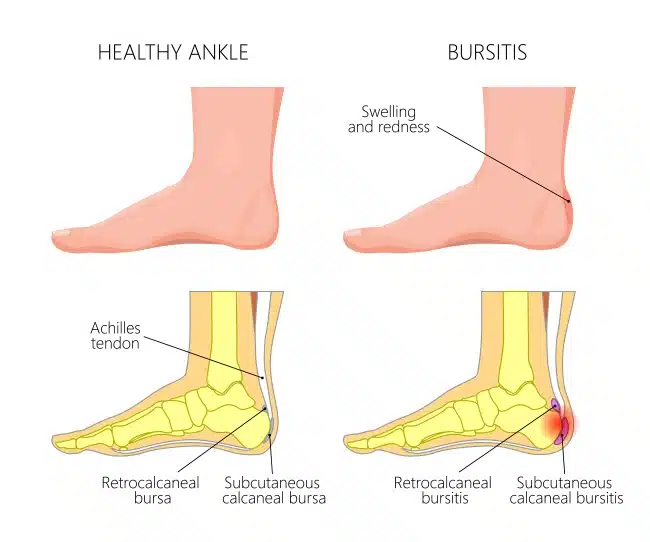
Retrocalcaneal vs. calcaneal bursitis
Two different conditions, calcaneal and retrocalcaneal bursitis, can be lumped into the same topic. These are technically two different conditions based on the bursa that is aggravated. The calcaneal bursa is located between the skin at the back of the heel and the heel bone or calcaneus. The retrocalcaneal bursa is positioned between the Achilles tendon and the heel bone right next to where the Achilles tendon inserts. While these are different issues, the general treatment would not be very different between the two, but it would make a difference when getting an injection.
Causes of Calcaneal Bursitis
Calcaneal bursitis is caused by a variety of factors. Repetitive movements can irritate the bursa in the heel over time, resulting in inflammation and pain. Direct trauma can also cause it, such as a fall or injury. Additionally, medical conditions that affect the bursa can increase the risk of calcaneal bursitis, including gout and rheumatoid arthritis.

Symptoms of Calcaneal Bursitis
The primary symptom of calcaneal bursitis is a dull ache that is concentrated in the heel, which can become sharp and intense when the area is touched or pressure is applied. The pain does not typically travel up into the Achilles tendon and is also not located up on the bottom of the foot or in the arch.
Those suffering from calcaneal bursitis may also experience swelling and redness near the affected area. Often, there are issues with range-of-motion of the ankle, specifically in dorsiflexion, like when someone walks on their heels by lifting their toes and balls of the feet.
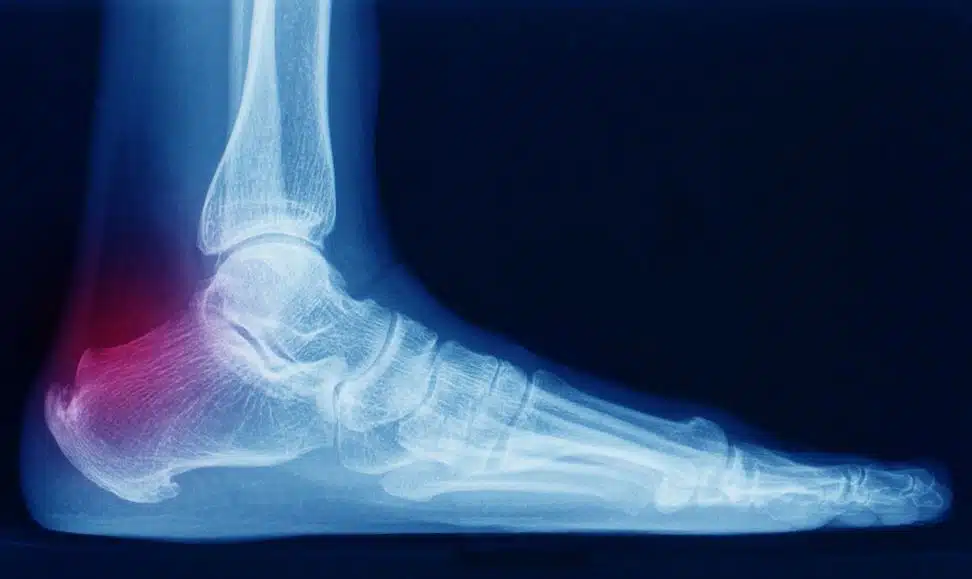
Diagnosis of Calcaneal Bursitis
A doctor can diagnose calcaneal bursitis by performing a physical examination, looking for signs of inflammation and tenderness in the heel area. In some cases, an X-ray or MRI may be necessary to rule out other possible causes of pain in the heel area.
Some conditions that may mimic calcaneal bursitis, or present similar symptoms include:
- Achilles Tendonitis
- Achilles Tendon Injuries (Strain)
- Achilles Tendon Rupture
- Plantar Fasciitis
- Tumors (such as intraosseous lipoma)
- Calcaneal Apophysitis (Sever Disease)
- Stress Fractures
- Rheumatoid Arthritis (RA)
Treatment Options
The treatment of calcaneal bursitis will depend on the underlying cause. In most cases, more conservative types of treatments can be used to reduce pain and inflammation. Occasionally, a combination of medications and injections is needed to resolve the problem.
Rehabilitation and chiropractic care can all be beneficial for those suffering from calcaneal bursitis. Corrective exercises can help strengthen the muscles in the foot and ankle, improving range-of-motion and allowing for more mobility. It can also help reduce pain and inflammation by using techniques such as massage. Stretching is important to make sure the associated structures have the proper mobility. Rehabilitation can help with mobility by teaching patients how to perform daily activities without aggravating their symptoms, while chiropractic care can help realign the spine and provide targeted relief from calcaneal bursitis pain.
Graston Technique can be a beneficial tool for those suffering from calcaneal bursitis. Graston Technique is a form of manual therapy that involves the use of specialized stainless-steel tools to break up scar tissue and adhesions in the affected area. This form of treatment encourages blood flow and healing while reducing pain and inflammation.
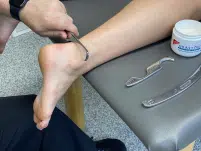
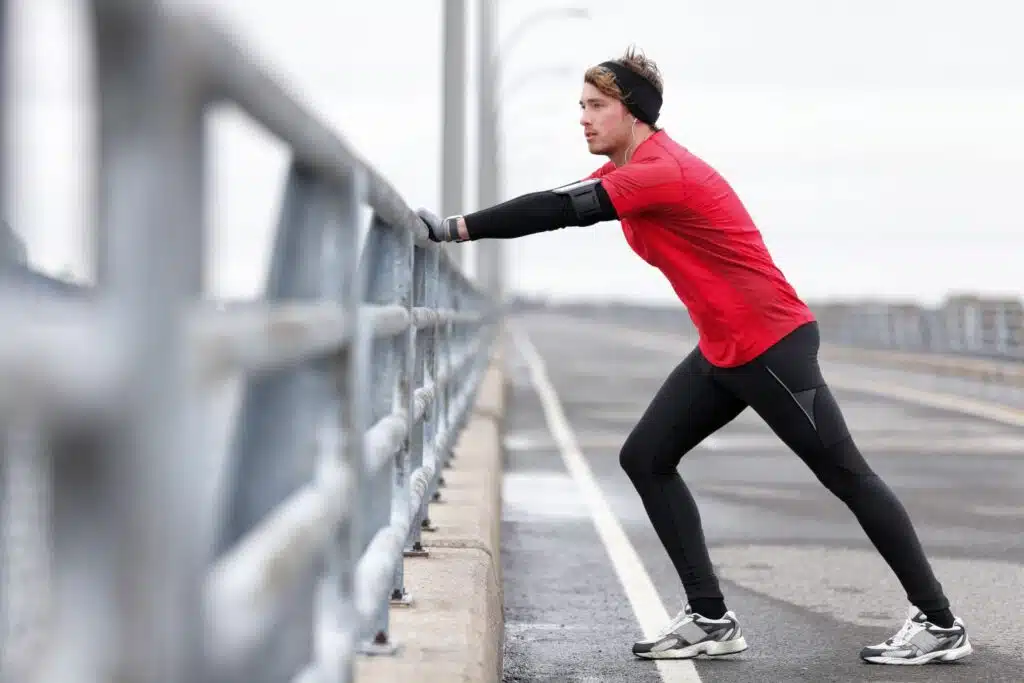
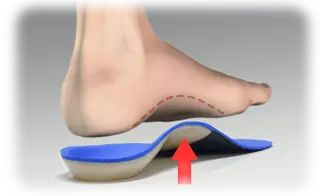
Cold laser therapy is a non-invasive, painless treatment that can help those suffering from calcaneal bursitis. This form of light therapy works by stimulating the body’s natural healing processes and increasing circulation to the affected area. By using specific wavelengths of light, cold laser therapy helps reduce inflammation, swelling, and pain associated with it.
Orthotics may be appropriate depending on the patient’s examination. Heel lifts are not something that I often use in my practice but may be appropriate for some individuals . Another thing that can help people perform is kinesio taping. Kinesio tape applied by a trained provider can help decrease pain and lead to better performance in those that are suffering from calcaneal bursitis.
Corticosteroid injections may be used to target inflammation. Medications, such as non-steroidal anti-inflammatory drugs (NSAIDs), can help decrease pain and swelling. Resting the affected foot and elevating it above the heart can also help reduce symptoms. In severe cases, surgery may be necessary to remove the inflamed bursa.
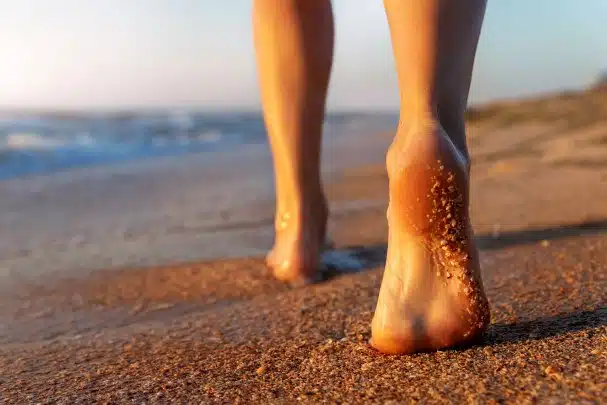
Prevention Strategies for Calcaneal Bursitis
Preventing calcaneal bursitis can be done in a few ways. First, those engaging in activities that involve repetitive foot motions should take frequent breaks to avoid overuse of the area. Secondly, proper footwear is essential for prevention, as shoes that are too tight or have inadequate cushioning can put a strain on the heel and increase the risk. Finally, maintaining a healthy lifestyle through exercise, stretching and good nutrition can help keep the feet strong and flexible, which can reduce the risk of calcaneal bursitis.
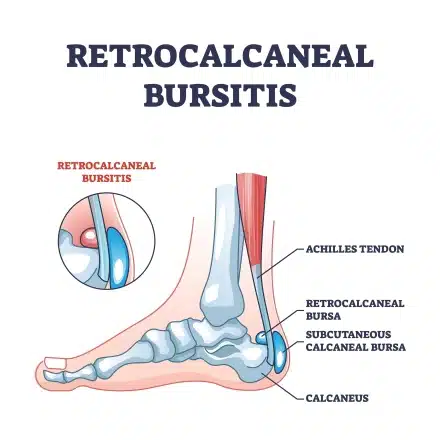
Conclusion
Calcaneal bursitis can cause a great deal of pain and discomfort, but with the right treatment plan, it is possible to reduce symptoms. Treatments such as corrective exercises, chiropractic care, Graston Technique and cold laser therapy are all options that may help alleviate calcaneal bursitis-related pain and inflammation. Additionally, preventive strategies like taking frequent breaks from activity involving repetitive foot motions or wearing proper shoes can also be beneficial for reducing risk.
If you’re suffering from calcaneal bursitis, we invite you to make an appointment with Harmony Chiropractic today so our team of experts can develop a personalized treatment plan tailored just for you!
Calcaneal Bursitis can be an incredibly painful and debilitating condition, but with the right combination of treatments, it is possible to find relief.
